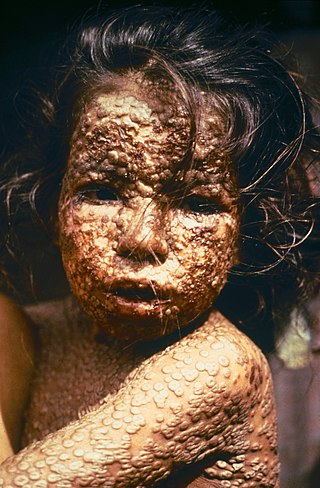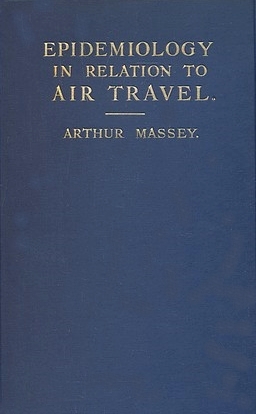Related Research Articles

Edward Jenner, was an English physician and scientist who pioneered the concept of vaccines and created the smallpox vaccine, the world's first vaccine. The terms vaccine and vaccination are derived from Variolae vaccinae, the term devised by Jenner to denote cowpox. He used it in 1798 in the title of his Inquiry into the Variolae vaccinae known as the Cow Pox, in which he described the protective effect of cowpox against smallpox.

Vaccination is the administration of a vaccine to help the immune system develop immunity from a disease. Vaccines contain a microorganism or virus in a weakened, live or killed state, or proteins or toxins from the organism. In stimulating the body's adaptive immunity, they help prevent sickness from an infectious disease. When a sufficiently large percentage of a population has been vaccinated, herd immunity results. Herd immunity protects those who may be immunocompromised and cannot get a vaccine because even a weakened version would harm them. The effectiveness of vaccination has been widely studied and verified. Vaccination is the most effective method of preventing infectious diseases; widespread immunity due to vaccination is largely responsible for the worldwide eradication of smallpox and the elimination of diseases such as polio and tetanus from much of the world. However, some diseases, such as measles outbreaks in America, have seen rising cases due to relatively low vaccination rates in the 2010s – attributed, in part, to vaccine hesitancy. According to the World Health Organization, vaccination prevents 3.5–5 million deaths per year.

Travel medicine or emporiatrics is the branch of medicine that deals with the prevention and management of health problems of international travelers.

Oswaldo Gonçalves Cruz, better known as Oswaldo Cruz, was a Brazilian physician, pioneer bacteriologist, epidemiologist and public health officer and the founder of the Oswaldo Cruz Institute.

The New World of the Western Hemisphere was devastated by the 1775–1782 North American smallpox epidemic. Estimates based on remnant settlements say at least 130,000 people were estimated to have died in the epidemic that started in 1775.
The International Sanitary Conferences were a series of 14 international meetings held in response to growing concerns about human disease epidemics. The first of the Sanitary Conferences was organized by the French Government in 1851 to standardize international quarantine regulations against the spread of cholera, plague, and yellow fever. In total 14 conferences took place from 1851 to 1938; the conferences played a major role in the formation of the Office international d'hygiène publique before World War II, and the World Health Organization in 1948.

The International Certificate of Vaccination or Prophylaxis (ICVP), also known as the Carte Jaune or Yellow Card, is an official vaccination report created by the World Health Organization (WHO). As a travel document, it is a kind of medical passport that is recognised internationally and may be required for entry to certain countries where there are increased health risks for travellers.

Smallpox was an infectious disease caused by variola virus which belongs to the genus Orthopoxvirus. The last naturally occurring case was diagnosed in October 1977, and the World Health Organization (WHO) certified the global eradication of the disease in 1980, making smallpox the only human disease to be eradicated.
Disease in colonial America that afflicted the early immigrant settlers was a dangerous threat to life. Some of the diseases were new and treatments were ineffective. Malaria was deadly to many new arrivals, especially in the Southern colonies. Of newly arrived able-bodied young men, over one-fourth of the Anglican missionaries died within five years of their arrival in the Carolinas. Mortality was high for infants and small children, especially for diphtheria, smallpox, yellow fever, and malaria. Most sick people turned to local healers, and used folk remedies. Others relied upon the minister-physicians, barber-surgeons, apothecaries, midwives, and ministers; a few used colonial physicians trained either in Britain, or an apprenticeship in the colonies. One common treatment was blood letting. The method was crude due to a lack of knowledge about infection and disease among medical practitioners. There was little government control, regulation of medical care, or attention to public health. By the 18th century, Colonial physicians, following the models in England and Scotland, introduced modern medicine to the cities in the 18th century, and made some advances in vaccination, pathology, anatomy and pharmacology.
In 1767, the 11-year-old composer Wolfgang Amadeus Mozart was struck by smallpox. Like all smallpox victims, he was at serious risk of dying, but he survived the disease. This article discusses smallpox as it existed in Mozart's time, the decision taken in 1764 by Mozart's father Leopold not to inoculate his children against the disease, the course of Mozart's illness, and the aftermath.
Variolation was the method of inoculation first used to immunize individuals against smallpox (Variola) with material taken from a patient or a recently variolated individual, in the hope that a mild, but protective, infection would result. Only 1–2% of those variolated died from the intentional infection compared to 30% who contracted smallpox naturally. Variolation is no longer used today. It was replaced by the smallpox vaccine, a safer alternative. This in turn led to the development of the many vaccines now available against other diseases.

The history of smallpox in Mexico spans approximately 520 years from the arrival of the Spanish to the official eradication in 1951. It was brought to what is now Mexico by the Spanish, then spread to the center of Mexico, where it became a significant factor in the fall of Tenochtitlan. During the colonial period, there were major epidemic outbreaks which led to the implementation of sanitary and preventive policy. The introduction of smallpox vaccination in New Spain by Francisco Javier de Balmis and the work of Ignacio Bartolache reduced the mortality and morbidity of the disease.
The 1947 New York City smallpox outbreak occurred in March 1947 and was declared ended on April 24, 1947. The outbreak marked the largest mass vaccination effort ever conducted for smallpox in America. Within three weeks of the discovery of the outbreak, the U.S. Public Health Service, in conjunction with New York City health officials, had procured the smallpox vaccine and inoculated over 6,350,000 adults and children. Of that number, 5,000,000 had been vaccinated within the first two weeks. The rapid response was credited with limiting the outbreak to 12 people, 10 of whom recovered, while 2 died.

Hélène Sparrow, was a Polish medical doctor and bacteriologist. She is best known for her work on the control of many epidemics including: typhoid fever, cholera, dysentery, and smallpox. Throughout the 1920s, Sparrow worked with the Polish Armed Forces at the State Institute of Hygiene in Warsaw. While at the State Institute of Hygiene, she worked vigilantly to produce the first vaccine against typhus and ran several large-scale vaccination campaigns to control the spread of diphtheria and scarlet fever all along the eastern frontiers of Poland. In 1933, Sparrow began to study flea-borne and louse-borne rickettsia diseases in Tunis, where she became the head of her own department at the Pasteur Institute. In her later years, she expanded her studies to include Mexico and Guatemala. While in Mexico and Guatemala, Sparrow developed a protective vaccine against typhus. She contributed a great amount of research to the World Health Organization on relapsing fever specifically in Ethiopia.
Inoculation is the act of implanting a pathogen or other microbe or virus into a person or other organism. It is a method of artificially inducing immunity against various infectious diseases. The term "inoculation" is also used more generally to refer to intentionally depositing microbes into any growth medium, as into a Petri dish used to culture the microbe, or into food ingredients for making cultured foods such as yoghurt and fermented beverages such as beer and wine. This article is primarily about the use of inoculation for producing immunity against infection. Inoculation has been used to eradicate smallpox and to markedly reduce other infectious diseases such as polio. Although the terms "inoculation", "vaccination", and "immunization" are often used interchangeably, there are important differences. Inoculation is the act of implanting a pathogen or microbe into a person or other recipient; vaccination is the act of implanting or giving someone a vaccine specifically; and immunization is the development of disease resistance that results from the immune system's response to a vaccine or natural infection.

The Public Health (Aircraft) Regulations 1938, created by the Ministry of Health, dealt with preventing the entry of infectious diseases into Britain via aircraft, applied to all HM Customs and Excise approved airports where foreign aircraft land and came into force on 1 July 1938. They were constructed to comply with the Office International d'Hygiene's International Sanitary Convention for Aerial Navigation, first drafted in Paris in 1930. The regulations established sanitary aerodromes and its administration was the responsibility of the town councils.

An immunity passport, immunity certificate, health pass or release certificate is a document, whether in paper or digital format, attesting that its bearer has a degree of immunity to a contagious disease. Public certification is an action that governments can take to mitigate an epidemic.
Vaccination requirements for international travel are the aspect of vaccination policy that concerns the movement of people across borders. Countries around the world require travellers departing to other countries, or arriving from other countries, to be vaccinated against certain infectious diseases in order to prevent epidemics. At border checks, these travellers are required to show proof of vaccination against specific diseases; the most widely used vaccination record is the International Certificate of Vaccination or Prophylaxis. Some countries require information about a passenger's vaccination status in a passenger locator form.
The International Sanitary Convention for Aerial Navigation (1944) was an international sanitary convention, one of the international co-operation land-marks in the history of public health, signed in Washington on 15 December 1944, and came into force on 15 January 1945.

Epidemiology in Relation to Air Travel is a book by Arthur Massey, the medical officer of health of Coventry, published by H. K. Lewis & Co. in 1933. By comparing the travel times of journeys by ship to those of travelling by air, he demonstrated how the quarantinable diseases plague, cholera, yellow fever and smallpox, could arrive in the UK in the early 1930s.
References
- 1 2 Stock, P. G. (24 May 1946). "Progress and Problems in Port Health Administration". Proceedings of the Royal Society of Medicine. 39 (10): 660–672. doi: 10.1177/003591574603901015 . PMC 2181927 . PMID 19993379.
- ↑ Whittingham, H. E. (March 1939). "Preventive Medicine in Relation to Aviation". Proceedings of the Royal Society of Medicine . 32 (5): 455–472. doi:10.1177/003591573903200533. ISSN 0035-9157. PMC 1997529 . PMID 19991846.
- ↑ "International Sanitary Convention for Aerial Navigation" . The American Journal of International Law. 31 (1): 28–50. 1937. doi:10.2307/2213596. ISSN 0002-9300. JSTOR 2213596.
- ↑ Byrns, Joseph W. (1932). Treasury Department Appropriation Bill for 1933: Hearing[s] Before the Subcommittee of House Committee on Appropriations ... in Charge of the Treasury Department Appropriation Bill for 1933. U.S. Government Printing Office. p. 512.
- 1 2 United States Naval Medical Bulletin. U.S. Government Printing Office. 1943. p. 119.
- 1 2 Stock, P. G. (1945). "The International Sanitary Convention of 1944". Proceedings of the Royal Society of Medicine. 38 (7): 309–316. doi:10.1177/003591574503800701. PMC 2181964 . PMID 19993068.
- ↑ International Sanitary Convention for Aerial Navigation, of 1944, Modifying the International Sanitary Convention for Aerial Navigation of April 12, 1933: Message from the President of the United States Transmitting a Certified Copy of the International Sanitary Convention for Aerial Navigation, 1944, Modifying the International Sanitary Convention for Aerial Navigation of April 12, 1933, which was Signed for the United States of America, at Washington on January 5, 1945. Washington, D.C.: U.S. Government Printing Office. 1945. p. 25. Retrieved 4 December 2020.
- ↑ International Sanitary Convention of 1944, Modifying Convention of June 21, 1926: Message from the President of the United States Transmitting a Certified Copy of the International Sanitary Convention of 1944, Modifying the International Sanitary Convention of June 21, 1926, which was Signed for the United States of America at Washington on January 5, 1945. Washington, D.C.: U.S. Government Printing Office. 1945. p. 23. Retrieved 4 December 2020.
- ↑ International Flight Information Manual. Volume 9. Washington, D.C.: Federal Aviation Agency. 1960. p. 8. Retrieved 4 December 2020.